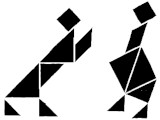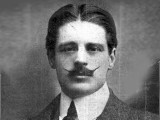

|
 | Louis Nikola(1878-1936) |  |
||
|
Louis Nikola was the stage name of magician and hand shadow performer Walter James Obree Smith, born in Southampton on 14th March 1878. He appears to have been raised in Brixton by his maiden aunts. The 1891 census shows him working as a stenographer typist, but his passion was performing illusions. In 1898 he contributed a series of "how to" magic articles in the Boy's Own Paper entitled The "B.O.P." Magician and towards the end of 1899 he began performing at concerts as Louis Nikola, a name taken from a series of popular potboilers written by Guy Boothby and featuring criminal scientist Dr Nikola and his quest for the Tibetan secrets of eternal life. Louis Nikola was one of the 23 magicians who attended a meeting at Pinoli's Restaurant in Soho on 1 July 1905 with the aim of forming a magicians' society. The idea had been promoted by magicians Neil Weaver and Martin Chapender, and following Chapender's untimely death from menigitis Weaver wanted to name the society after him. This was not accepted by the meeting: it is recorded that it was Nikola who observed that the name Magic Circle shared Martin Chapender's initials. Nikola contributed several articles to the Strand Magazine, largely on scientific parlour tricks and novelties, and in September 1911 wrote an article on Hand Shadows for The Magic Wand, the Magic Circle's magazine. By this time he was appearing in Maskelyne & Devant's Mysteries at St George's Hall, Oxford Circus. In 1913 he married Gertrude Stackemann, known as Grace. They settled in New Malden and raised two sons, Andre and David, moving to Hendon in 1925. Also in 1913 Nikola published a book on Hand Shadows, and appeared in a film called Spiritualism Exposed in which a girl is swindled out of her inheritance by a phoney medium working for a criminal gang. Her fiancé calls in the police and they set out to expose the fraudulent seance and regain the money. It is not clear whether it was the film company or Nikola who proposed the original idea but he clearly provided knowledge of the tricks used to create the seance effects. He is credited with the part of "the chief", which is either the chief of police or, more likely, the head of the fake spiritualists. The film was directed by Charles Raymond for production company Francis-Clare & Bamberger who later the same year changed their name to the Motograph Film Co Ltd. The film's title brought complaints from Spiritualist organisations and it was subsequently renamed Fraudulent Spiritualism Exposed. Louis Nikola is not credited with any other movie appearances, but the following year, 1914, he made an animated film called Magic Squares for the British & Colonial Kinematograph Company. The review from Kinematograph Weekly 13 August describes it thus: The essence of the whole clever novelty is the way in which the talented artist makes his figures express emotion. The lady and gentleman quarrel and there comes "eviction." Then two cats come on the scene, followed by skirt dancers and boy scouts, and finally two prehistoric monsters the Wiggywoggie and the Gobbleyewup. In case you missed it, the second monster is pronounced "gobble-yew-up". In The Strand Magazine, January 1907, Nikola had published an article titled Euclid Inebriated which consisted of a series of humorous illustrations constructed from tangrams (the set of seven polygons that can be arranged to form a perfect square). [See picture at top left.] A sequence of images tells a tale entitled The Story of the Unjust Lodger and the Virtuous Landlady, in which a lodger complains about the age of his breakfast bloater. A fierce row ensues and finally a policeman arrives and kicks out the ungrateful lodger. Further pictures are captioned When Johnny Comes Marching Home; The Guileless Maiden and the Dreadful Duke ("a murderous Melodrama"); The Fiscal Policy (two gentlemen engaged in "a quiet, friendly discussion" on that subject); A Friendly Argument (two ladies discussing the subject of dress); and finally A Skirt Dance and a Cake Walk. This article may well have started life as an idea for a humerous novelty act in which the performer would swiftly arrange the pieces as he told the story. There are clearly parallels between this article and the above description of Magic Squares. The director of Fraudulent Spiritualism Exposed, Charles Raymond, also directed many films for British & Colonial, so it is possible he introduced Nikola to B&C producer J B McDowell. While we are in the realm of speculation, in August-September 1911 Nikola was appearing in Maskelyne & Devant's Mysteries at St George's Hall on the same bill with Ernest H Mills, a painter and photographer who performed on stage as a lightning cartoonist and 'art humorist'. Mills would later become an animator, working for Kine Komedy Kartoons and his stage act would have had something in common with my conjectured tangrams act, so it is possible that Magic Squares could have been a collaboration between Nikola and Mills. This is, however, pure speculation on my part and there is no evidence at all to support the idea. Nikola seems to have had no further involvement with films, concentrating on his stage performances. In 1927 he published The Nikola Card System, a description of his sophisticated sequence for an arranged pack of cards, with 23 different effects that could be performed with it and an appendix on pack manipulation, and in 1934 he published Magical Masterpieces, a collection of 48 illusions from his reportoire. As a magician he is known for his improved Card Castle, where knocking the table causes the tower to collapse, demonstrating its fragility, and his Magic Welding where loose rings poured from a tray into a cup are seen to be linked into a chain when poured back onto the tray. Louis Nikola died on 11 November 1936, at the age of 58.
|
Filmography (animation) | ||||
| Magic Squares | (British & Colonial 1914) Creator | |||
Links to Other Sites | ||||
Peter Hale
Last updated 2021
|